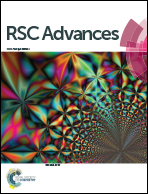Impact of carboxylation and hydrolysis functionalisations on the anti-oil staining behaviour of textiles grafted with poly(N-isopropylacrylamide) hydrogel
Abstract
Novel hydrogel-modified textiles have been prepared through photografting poly(N-isopropylacrylamide) (PNIPAAm) onto pristine and functionalised polyethylene terephthalate (PET) surfaces. In this work, two types of functionalisation, carboxylation (CPET) and hydrolysis (HPET), were performed to scrutinise the hydrogel grafting efficiency. Basic characterisation of the pristine, functionalised and grafted textiles was carried out via fourier transform infrared spectroscopy (FTIR), atomic force microscopy (AFM) and field emission scanning electron microscopy (FESEM) analyses. Then, the functional characteristics of these samples were determined based on the oil staining performance. Functionalisation of the PET textiles via hydrolysis and carboxylation gives rise to different chemical reactivity and interactions on the PET surface. Impressively, the surface formed via hydrolysis functionalisation of PET was found to be more efficient compared to that formed via carboxylation, and the untreated one. The HPET surface was remarkably more hydrophilised and rougher than both the UPET and CPET surfaces. The accessibility of the –OH groups for hydrogen abstraction from HPET has a great impact on the hydrogel grafting onto the HPET surface. All the grafted textiles (PNIPAAm-g-UPET, PNIPAAm-g-CPET and PNIPAAm-g-HPET) demonstrated anti-oil staining behaviour at 27 °C. In particular, PNIPAAm-g-HPET textiles with a high degree of grafting (DG) exhibited the fastest rate for oil to de-stain from the surface. Moreover, the reversible transition of PNIPAAm hydrogels around the lower critical solution temperature (LCST) ∼ 32 °C from hydrophilic to hydrophobic generates switchable surfaces of the textiles with regard to the oil wettability. Specifically, PNIPAAm-g-HPET textiles also displayed the highest degree of wettability switching as a result of having the highest DG. Taken together, the PNIPAAm hydrogels grafted onto PET textiles were significantly enhanced though hydrolysis functionalisation and possessed excellent switchable surfaces toward oil-staining, having great potential to be used for applications in oil and water separation as well as smart textiles.



 Please wait while we load your content...
Please wait while we load your content...